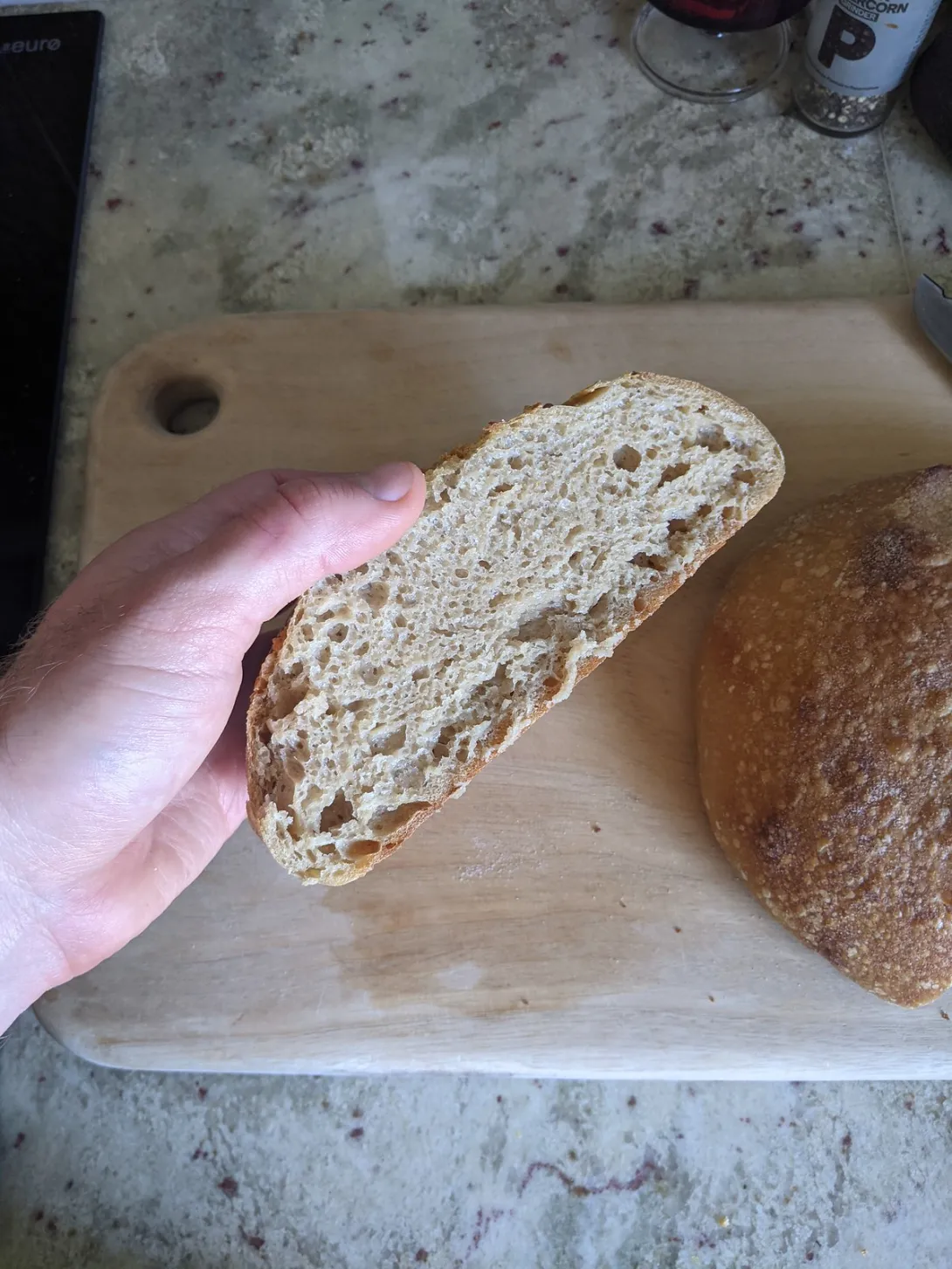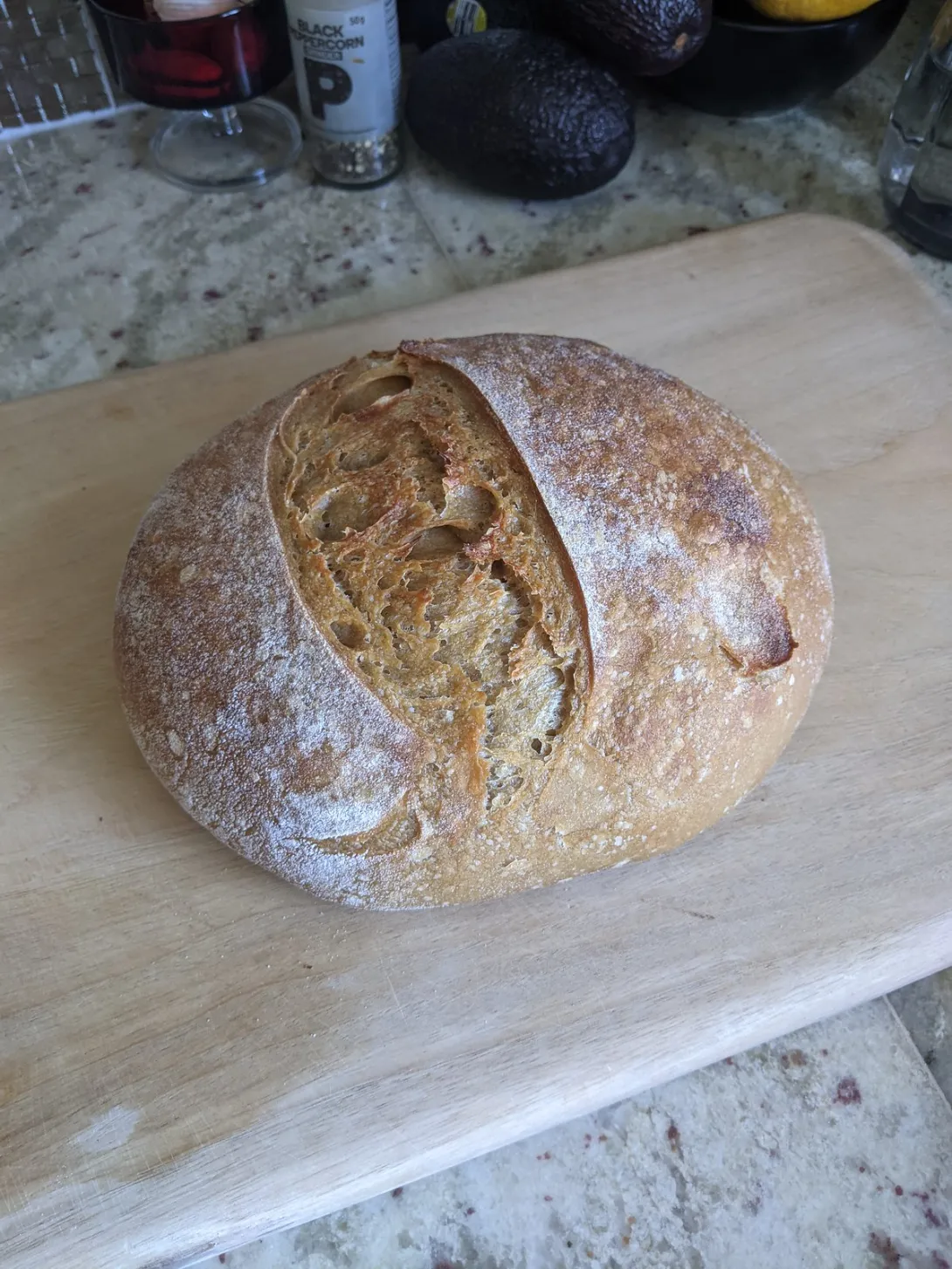Hi fresh loaf community
Can someone please tell me if this bread looks overproofed or underproofed? I have been using a new flour and having trouble getting loaf with good volume/nice crumb
70% hydration
15% starter/levain
Temp 26c
Bulk proof approx 5.5- 6hrs
3 stretch folds 30mins followed by 2 1hr
Overnight proof in fridge followed by bake next morning
Any feedback appreciated
Image
 Image
Image

My guess is just a little over-proofed and under-hydrated. Both due to the use of a portion of rye flour, or whole-grain flour, or high-extraction (contains more bran) flour.
Inclusion of rye or bran/germ via whole-grain or high-extraction flour boosts the fermentation rate. To compensate, you can decrease the % of levain, or decrease the bulk-ferment time, or decrease the proof time.
Whole-grain also causes dough to ferment faster in the refrigerator during the proof stage.
This part is unclear:
"Bulk proof approx 5.5- 6hrs
3 stretch folds 30mins followed by 2 1hr"
Are the stretch and folds included in the 6 hr bulk, or in addition to the 6 hour bulk?
Thanks.
The stretch and fold were included in the 6hr bulk. So would you recommend using a mixture of Bakers/white flour with whole grain flour to achieve better volume/crumb.
I was using stone ground wholemeal flour
I might drop the hydration down to 67% and see what happens.
what's the flour?
I'm using heritage wholewheat flour from wholegrain milling. It has a strong protein content 13.2. Does wholegrain react differently to regular Bakers flour/white flour?
Hi,
I was actually interested in that flour and it's my next (well, equal next, with khorosan) purchase once I use up some of my bulging stocks! I e-mailed the team at the mill and they said that it:
They didn't say what those differences are but I can give you some information on wholemeal/wholewheat/wholegrain flour compared to white.
Gluten potential
The main points are:
Therefore, if you take a particular wheat crop and make it into two batches of flour - one white and one wholemeal - the white will have a lower protein percentage but a higher gluten-forming potential, while the wholemeal will have a higher protein percentage but a lower gluten forming potential!
Just doing some simple calculations, using simple percentages, imagine that the breakdown of the whole wheat berry is: bran 15%, endosperm 85%.
Now, when you look at 'bran' on the supermarket shelf (i.e. what you might sprinkle on your cereal or add into muffins,) you will note that it's around 16% protein, as compared to 'ordinary' supermarket white flour with 10% protein. Let's assume that the protein content of the bran is variable, like the protein content of the wheat (i.e. some wheat is lower or higher protein) but that they scale with each other. From that let's ASSUME that the bran has 1.6x the protein of the endosperm.
Long story short, that calculation ends with a 13.2% protein wholemeal flour having an effective gluten-forming protein level of 12.1%.
I.e. the 13.2% protein wholemeal flour is equivalent to a 12% white flour - so far as gluten potential is concerned.
Again, these are stupidly rough numbers and somewhat unrealistic assumptions and generalisations but they serve the required purpose, which is to show that, because all the gluten is in the 'white' portion of the flour, ANY inclusions will dilute that and reduce the gluten-forming potential of the flour.
Particle size and physical 'damage'
Short version: bran particles are 'sharp' and can 'cut' and damage the gluten strands when you're mixing and developing the dough. The generally accepted mitigation is a longer autolyse - an hour or more.
Chemical damage
Again, short version: the bran contains various components that disrupt gluten formation at a chemical/molecular level. Bad news is that there's no real way around this (for the home baker).
Water absorption
Bran absorbs more water that the endosperm so if you use have a recipe you are happy with using white flour and then change to using either 100% wholemeal of some significant percentage (say, >25%) wholemeal, the hydration level will need to be increased to compensate. If you don't, the bran will effectively out-compete the 'white' flour portion and there won't be enough water for proper gluten formation and development.
Beneficial aspects
It's not all negative news, though! Bran also contains enzymes that assist in breaking down the flour so that the yeast can do its thing. That said, that's not a one-way street as your dough will generally ferment faster - assuming of course that hydration has been adjusted.
Again, if you have a recipe you're happy with and then change to wholemeal, you'll need to either cut back on your yeast/starter or cutback on the fermentation time - else you risk over-fermenting.
Summary
When compared to white flour, wholemeal changes the game as follows:
Oh - I forgot to mention the most important positive, though - wholemeal is DELICIOUS!!!! (I.e. it's worth dealing with the negatives or figuring out the best ways to mitigate them because the end result is worth it and, after all, not all loaves have to be instagram-worthy towers of aeration - good bread is good bread regardless of how it looks!)
d
Wow, thanks for the write up Dan. The taste of the flour itself is really tasty
I think for next bake I will try a mixture of white flour with this flour.
Do you have any recommended flours that you use yourself Dan?
Currently, I am using good ol' Laucke Wallaby as it's easily available. Alongside that, I am using Caputo Saccorosso, which is a 00 flour but quite strong (by our standards). I bought it for a pizza fest but could only get it in a 15kg bag so I have rather a lot still to go through. It's fairly decent.
My standard add-in flours are a light/medium rye and white and wholemeal spelt, as well as semola (also Caputo) and some off-the-shelf Lighthouse strong wholemeal flour, but my partner has a strong preference for white so I don't go through much of that and can't get away with more than 10% rye as an upper limit.
So no real recommendations - I lke to use what's available and try to make the go of it that I can. To that end, I've also been experimenting with Woolies plain flour as I found that it is currently showing 10.9% protein, which is quite high for standard plain flours (at least here!). Makes a totally reasonable baguette as it's right in that range (just needs a little help getting the flavour).
d.